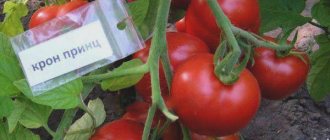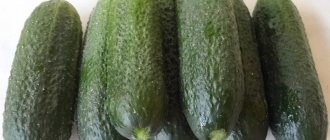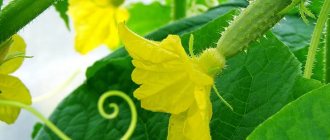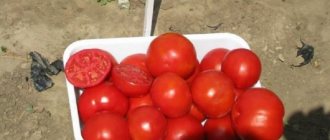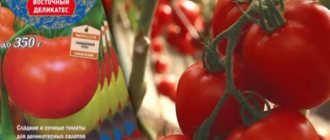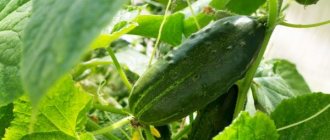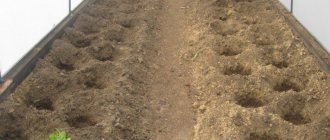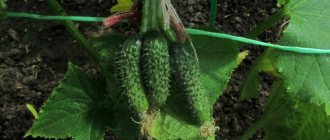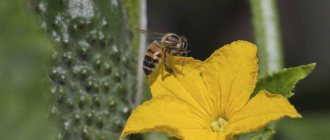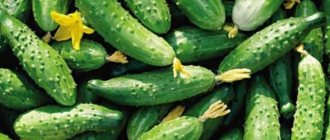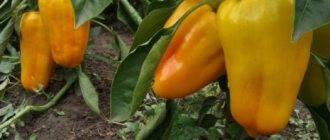Cucumber Son of Regiment F1 is liked by professionals and novice gardeners for its excellent taste and significant productivity. Among the values of the hybrid is resistance to scab.
| Landing location | Ripening time | Mode of application | Fruit length | Group | Fruit smoothness | Pollination method |
| Open ground | Mid-early (46-55 days) | Universal | Short (gherkins) - less than 10 cm | Hybrid | Highly lumpy | Bee pollinated |
What do bushes and fruits look like?
The plant has a clearly visible main stem, while the side shoots are short and sparse. When grown in a greenhouse, the bush reaches a height of 1.5-2 m, in the open air it grows lower - 1-1.2 m in height. The leaves are of normal size, light green, slightly wrinkled.
Note! The hybrid Son of the Regiment produces predominantly female flowers - three ovaries for each nodal sinus. The proportion of barren flowers (male flowers) is minimal. Bees are needed to form fruits.
The son of the regiment is a gherkin variety. Cucumbers grow small in size:
- 7-9 cm in length;
- 2.5-3 cm in diameter.
Moreover, they have such a feature that they will not become larger than these sizes and will not turn yellow, even remaining on the bush after ripening. Therefore, the harvest is obtained from identical, neat, oval-shaped cucumbers.
The skin is dark green with medium-length light stripes, slightly ribbed. The surface is lumpy:
- the tubercles are quite large;
- rare;
- with light brown spines.
The skin is elastic, crispy, without a bitter aftertaste. The juicy pulp has a pleasant, rich taste. The weight of each cucumber does not exceed 100 g on average.
Which cucumbers are the most productive?
If your goal is a bountiful harvest, then choose early-ripening varieties of cucumbers for planting, which produce the most fruit in a short time. A yield of more than 5 kilograms per bush is considered high. Don't plant them too densely, as this may hinder growth.
Cucumber Brigadier F1
A hybrid that gives the first results of work after 7 weeks. Pollen is required for reproduction, so it is better to plant it in open ground. Each plant produces about 6 kilograms of cucumbers. When planting 3 bushes per square, you can get up to 18 kilograms. The fruits are bright green, not too large, the skin is covered with spiky tubercles.
Gypsy cucumber F1
A vigorous plant gives a good harvest: up to 5 kilograms per bush. The fruits are small, oval, with black edges on small tubercles. Each cucumber reaches 60-80 grams in weight and 9-11 centimeters in length. Suitable for canning and salads. The roots are strong and do not rot with abundant watering.
Variety indicators
The first fruits can be removed from the bushes 40-45 days after seed germination. With appropriate care, nutrition and proper access for bees to flowers, up to 10 kg of cucumbers can be collected per m2 of plantings.
You may be interested in:
The most productive varieties of cucumbers for open ground When spring begins, all gardeners are already on alert - seeds are selected and checked, containers are prepared...Read more...
The reason for such high yield figures for the Son of the Regiment variety is its:
- bunch type of flowering;
- immunity to common diseases;
- characteristic feature of fruits that do not ripen.
Advantages:
- High yields with beautiful, even cucumbers.
- They can be collected within a month and a half after sowing; this is a suitable time for the northern regions, where summer does not last long.
- The fruits do not outgrow their 9-10 cm length and do not turn yellow.
- The variety is well suited for collecting and preparing gherkins and pickles.
- You can grow cucumbers both in open areas and in greenhouse conditions.
- The variety is unpretentious, including to changing weather conditions;
Note!
Moderate branching and average height of the bushes do not create unnecessary problems in caring for them.
The hybrid has inherent resistance to frequent viral and fungal infections.
The variety has no significant deficiencies that affect yield. The only downside is bee pollination, namely the need to attract bees to greenhouses.
How do gherkins differ from other cucumbers?
Gherkin varieties are distinguished by elastic, crispy fruits without voids inside. They are oblong in shape, without bulges, the length of cucumbers is about 5-10 cm. Even overgrown gherkins will not be large. Breeders have developed varieties that ripen quickly, have a pleasant taste, produce large yields and are resistant to common diseases.
Attention! Gherkins have a higher mineral content than salad cucumbers. The best varieties have specific characteristics
The following groups are represented:
The best varieties have specific characteristics. The following groups are represented:
- for greenhouses;
- for open ground;
- for film coatings;
- bee-pollinated;
- self-pollinating;
- parthenocarpic (without pollination).
Having tried different varieties of miniature cucumbers, most gardeners choose the best ones for themselves and grow these particular gherkins.
Type of pollination
In the variety Son of the Regiment, flowering occurs according to a predominantly female type. This means that most flowers that bloom on bushes only have pistils. It is they who set cucumber fruits after pollination, which is why they are called ovaries. Three ovaries are formed in the axil of each leaf of this hybrid variety. The proportion of male flowers (barren flowers) on the bushes is small, but without pollen, fruits will not appear from their stamens. Pollen from barren flowers is transferred to the ovaries by bees and bumblebees.
Thus, full fruiting of plantings is possible under the following conditions:
- planting together with the main pollinator variety, that is, a hybrid with a male type of flowering;
- attracting bees and bumblebees to the planting area.
Typically, producers of bee-pollinated hybrids themselves add several seeds of the pollinating variety to the packaging. These seeds are colored compared to the others. Also, special symbols are added to the packaging: a yellow seed in a small pink square and the caption “colored seeds are a pollinator.”
If all this is not available, then you can always purchase a pack of pollinator seeds yourself. The following varieties are suitable for these purposes:
- Gladiator;
- Hercules.
Their seeds are planted together with the Son of the Regiment variety so that their share is at least 10%.
Open windows, greenhouse doors and the ends of film tunnels are sometimes not enough for bees to pollinate all ovaries. To ensure that each flower has enough of these buzzing pollinators, experienced gardeners lure them by irrigating cucumber bushes with syrup and planting honey-bearing flowers and spicy, aromatic herbs nearby.
Cucumber - characteristics of the culture
Cucumber is a vegetable, an annual plant of the dicotyledonous class, of the pumpkin family. Country of origin: India, at the foot of the Himalayas.
Description of the plant
The stem is rough, with tendrils with which the vegetable clings to supports, stretching up to two meters.
The leaf is five-pointed, heart-shaped.
The fruits are multi-seeded, green in color, different shades, juicy, aromatic. The shape is oblong, in botanical reference books it is defined as “pumpkin”.
The seeds are flat, elongated, white or cream in color.
Useful properties: Dietary vegetable. Improves digestion and intestinal function. Stimulates the functioning of the heart and kidneys. The juice (only freshly prepared) cleanses the joints. Treats external ulcers. Good for teeth and gums. Whitens and cleanses the skin.
Main conditions for growth
Growing cucumbers in open ground requires compliance with the terms, conditions and methods of cultivation:
- The timing of planting in open ground should prevent cucumbers from encountering frost;
- the yield is higher for crops climbing trellises;
- cucumbers grow well in a bed illuminated by the sun;
- Landings should not be carried out in the wind.
Disease and pest control
The creators of the Son of the Regiment variety instilled immunity in the plants to some specific diseases of cucumbers:
- scab;
- cucumber mosaic;
- powdery mildew;
- downy mildew.
But the fight against insect pests is the task of the summer resident. You can use ready-made solutions of insecticides or herbal decoctions and infusions. The first ones are best used in the period before fruiting.
Attention!
The drug Thunder helps against ants, against slugs - Slug Eater, against aphids - Iskra.
However, you can try to cope on your own:
- the smell of garlic or mint planted next to cucumbers repels ants, and the aroma of cilantro drives away mole crickets;
- ants can be poisoned with a mixture of boric acid and sugar;
- Irrigation of leaves with infusion of garlic or red pepper, or a decoction of celandine will help against aphids;
- You can “smoke” a mole cricket out of the ground in order to collect it manually by watering the ground with a soap solution;
- potassium-phosphorus fertilizers and wood ash, rich in potassium, repel slugs.
When preparing the land for sowing, the discovered anthills can be poured with boiling water, and when the crop has already been harvested, use a solution of copper sulfate.
Sowing, growing, care
One of the advantages of “Son of the Regiment” cucumbers is the unpretentiousness of the plants. However, the plantings are still not left without attention. Traditional care for growing bushes includes:
- loosening the soil and removing weeds;
- general measures for the formation of bushes;
- regular watering;
- application of fertilizers.
Seeds are usually sown directly into open ground in regions with a southern climate. In the area to the north, it is better to grow seedlings first. You can get down to business in mid-April. Prepare containers with enriched soil. Better seeds:
- first soak in potassium permanganate to get rid of bacteria;
- then soak for several hours in a honey solution, which is a natural growth stimulator.
Place two seeds in a pot, deepening it by about 1.5 cm. When the first leaves sprout, for selection purposes you can remove the sprout that is weaker in appearance. Containers with shoots are placed near windows, in the sun. Water regularly with warm water once every 4-5 days. Make fertilizing, at least one. The room temperature is maintained at 22 – 24 °C.
- After 20-25 days of growth, when each shoot has 3-5 leaves, the seedlings can be transplanted into the beds. In this case, a week before this, it is recommended to start hardening the seedlings, which consists of:
- reducing the frequency of watering;
- reducing the room temperature by five degrees;
- transferring seedlings to the shade.
And after a few days, the containers are placed outside for a short time (starting with ten minutes).
The soil on the site of future beds is pre-prepared:
- Choose open areas that are well lit by the sun.
- They dig up, loosen, enrich with mineral mixtures or peat.
- Before sowing, you can water the soil with a solution of a growth stimulator with the addition of a fungicide.
Only after the earth has warmed up to a temperature of 15 oC are the seedlings transferred to the beds or the seeds sown directly. This usually happens in the second half of May when planting in greenhouses and in the first week of June when choosing open ground.
Humus, compost or peat are first added to the holes, then watered with a small amount of warm water and the seeds are planted to a depth of 2 cm. The distance between holes is 30 cm, between rows - 50 cm. In the case of seedlings, 4-5 seedlings are planted per 1 m2. When all the seeds are in the ground, they are covered with film. It is removed as soon as the first leaves appear.
Note!
The soil under the bushes is usually loosened after watering, this prevents the formation of hard crusts.
It is advisable not to pick weeds, but to try to pull them out by the roots. After weeding the soil, to maintain moisture and limit the growth of weeds, you can lay a thin layer of straw or rotted sawdust, the so-called mulch, on the ground around the bushes. It will protect the root system from temperature changes, and when adding peat it will nourish it.
Cucumbers are moisture-loving plants. But excessive dampness will only be harmful: in such conditions, fungal diseases develop and the roots rot. Therefore, the frequency and volume of watering must be adjusted depending on the weather and growth stage. If during dry periods it is advisable to water the cucumbers daily or every other day, then during periods of rain they receive enough moisture. However, this does not apply to bushes growing in greenhouses. The frequency and volume of watering also increases during flowering and fruiting.
Recommendations:
- Water for irrigation is traditionally used warm, settled under the sun or in the greenhouse itself.
- The time is either early morning or evening at sunset.
- During the day they try not to water, because a lot of moisture evaporates before it reaches the cucumbers. In addition, when drops fall on the leaves, the sun during high hours can burn the leaves at the site of the drops.
Cucumbers of the Son of the Regiment variety are early ripening, and 3-4 fertilizer applications are usually planned for the season. During the growth of bushes until flowering, mullein, bird droppings or compost are mainly used. They are rich in nitrogen, which is useful for the plant to grow green mass.
During flowering, formation and ripening of fruits, the amount of organic nitrogen-containing fertilizers is reduced and potassium-phosphorus mixtures are added:
- potassium sulfate;
- nitrophoska;
- superphosphate.
Phosphorus is necessary in the formation of the root system, so superphosphate is often used to irrigate the soil around the roots. Tree bark can replace some potassium supplements; it is diluted in water and watered over plants.
Experienced summer residents also alternate feeding methods. On dry days, they choose to apply fertilizers at the roots, usually after watering. On cool days, the leaves are irrigated with a nutrient composition.
Note!
Often, a urea solution is used for this, obtained by adding 30 to 60 g of urea to 10 liters of water. The concentration of the solution increases as the plants grow.
The cucumber bushes of the hybrid “Son of the Regiment” are characterized by moderately pronounced branching and medium height. This makes it easier for the bushes to form as they grow. It is limited to the following measures:
- tying the bush with twine to a vertical support or trellis between the second and third leaves from the top without tightening the loop;
- pinching the top when it extends up to 50 cm from the trellis;
- removal of lateral branches and ovaries of the four lower leaves;
- shortening the upper side shoots if necessary.
As is the case with other early-ripening varieties, when harvesting Son of the Regiment cucumbers, it is useful to be guided by the rule that the more often you collect cucumbers during the fruiting period, the larger the harvest will be. During the period of active fruiting, it is recommended to collect them every day or every other day.
Features of agricultural technology
The variety is recommended for early planting even in open ground. Seeds can be planted when the air temperature reaches only +12 ° C. Usually this is the end of March or the beginning of April. Before sowing:
- seeds and soil must be disinfected:
- dig up the ground and remove all possible traces of the root systems of the previous harvest or weeds.
Reviews
Tamara Viktorovna, 63 years old
Son of the Regiment bought seeds and thought about sowing them in a greenhouse. Then I read that the variety is bee-pollinated. I was upset at first, but then I decided that I would put her straight into the station. I prepared the land just so that there would always be sun there and planted it with seedlings. So let them grow, I, of course, fertilized them well. I struggled with the supports and garters, but the cucumbers grew so beautiful, like a selection. Delicious, small. You can eat five pieces at a time.
Igor N., 55 years old
We have been planting Son of the Regiment cucumbers every year for four years now. In greenhouses, on trellises. I moved the hive there a long time ago. As the bushes bloom, the bees hum and work. My wife doesn’t really like to mess around with all these tendrils and lashes, so I mostly do it myself. And the Son of the Regiment, it seems to me, is very convenient here, does not require any unnecessary troubles. Cucumbers grow quickly, half the palm of your hand, but they don’t grow any further. Just right for us. I collected it almost every day and gave it to my wife, and she rolled it up. Now all year round we have neat and tasty gherkins.
The high-yielding variety Son of the Regiment produces cute, even, miniature cucumbers with a pleasant taste, which will decorate the table both fresh in summer and in winter in the form of delicious pickled gherkins.
Cucumbers for open ground
When growing by open method, it is necessary to especially carefully consider the varietal division by region. Zoning is an important element in selection; hybrids are created taking into account the most important characteristics of the area.
Self-pollinating or parthenocarpic varieties
Most plants require pollination to form fruit. Eliminating dependence on insects is one of the tasks of breeders. New varieties are coming to the aid of gardeners:
- Self-pollinating - pollination occurs on one plant (there are pistils and stamens). When the seeds ripen, the fruit turns yellow and dries out.
- Parthenocarpic plants produce only female flowers. The fruits do not turn yellow, there are no seeds or they are in rudimentary form, they are stored well, and produce a long and abundant harvest.
Among the disadvantages, we note the highest cost of seeds for hybrids of this species.
Prestige F1
This variety has a lot of undoubted advantages:
- long fruiting;
- sweet, without bitterness, greens;
- ripening in 42-45 days;
- beautiful shape: length – 10-12 centimeters, weight – 70-95 grams;
- thin skin, crispy flesh;
- tolerate transportation well.
Prestige is used fresh and for a variety of preparations.
Son-in-law F1
A good variety for the garden and greenhouse. Zelentsy have a diameter of 3.5 centimeters and a length of about 10-12. The ovary is grouped in bunches of up to 8 pieces. The variety is productive - up to 50 bunches on a bush; up to 7 kilograms of fruits are collected from a bush over the summer.
Claudine F1
Harvesting Claudine facilitates the open appearance of the bush. The greenery is 8-10 centimeters in size and weighs 80-90 grams. There are light stripes along the dark green skin, the bumps are small, but the cucumbers prick your hands very much. It is better to assemble with gloves. Up to 7 kilograms of excellent quality fruits are harvested per square meter.
Claudine is considered a salad variety, has a pleasant taste, but becomes softer in any type of preparation. The bushes tolerate heat well. From germination to harvesting – 38-40 days.
Metelitsa F1
The fruits are ready 37 days after emergence. The ovary is grouped into 4 pieces in a bunch. The cucumbers are small (7-8 centimeters, up to 70 grams) and have a regular cylindrical shape. The color of the greens is bright green, white stripes cover the cucumber up to the middle.
Planting - seeds in the ground and seedlings. Metelitsa is well suited for any method of use - fresh and for preparations.
Bogatyr strength F1
Cucumbers produce a large harvest - up to 20 kilograms per bush. If you collect greens in time, the plant bears fruit until September. The bush grows weakly, without taking away strength during the formation of the ovary and the growth of fruits.
The skin of the fruit is dense, the core is filled with pulp, and there are few seeds. Size – 8-14 centimeters, thickness – 3 centimeters. They are well stored (14 days without loss of quality) and transported. Good fresh and canned.
